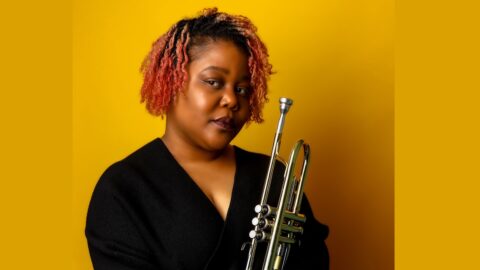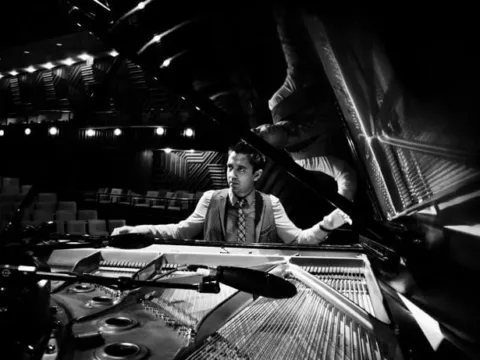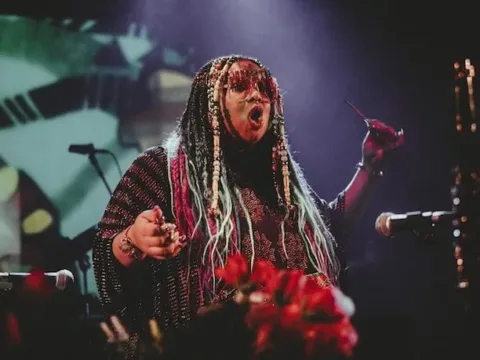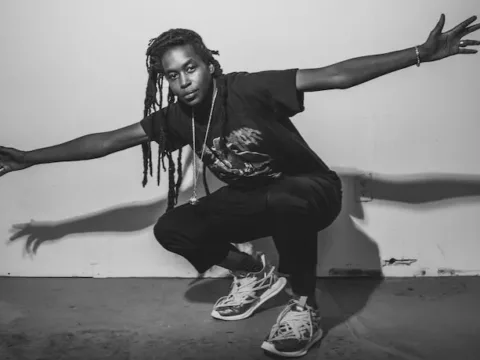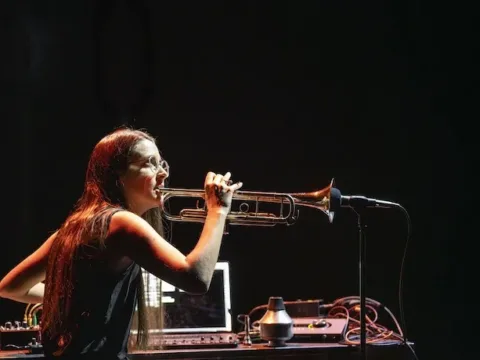Theresa May’s multifaceted work as an artist, performer, educator, and advocate illustrates the abundant possibility of a career centered on fully embracing your interests. A classically-trained trumpeter, May maintains a robust teaching schedule at Cuyahoga Community College where she serves as a professor of applied trumpet and world music.
Outside of the classroom, however, May transforms into a conduit for the fullness of Black art and advocacy. Under the name Di·zy·got·ic Energy, May’s multimedia composition projects meld trumpet, voice, electronic music, and a mixture of hop-hop, soul, and funk. The results are groovy and sultry soundscapes that display the benefits of disposing of genre. Her latest release, “Purpose (Remix),” powerfully captures this by inviting the listener in with colorful and rich electronics before asking us to rethink our greater purpose through the repeated refrain, “we are one.”
May’s commitment to activism is most evident through her collaborations. During the pandemic, she co-founded Chromatic Brass Collective along with six other Black women brass players. The organization, which aims to increase the stature of underrepresented women and gender non-conforming brass players, has mended a significant hole in the brass community through workshops, performances, and annual consortium.
May is also a member of Mourning [A] BLKstar, a “genre non-conforming” band that is “dedicated to sharing stories and songs of America’s unfolding apocalypse” and highlighting the sounds of the African diaspora by combining live music and hip-hop production. Other significant collaborations include “Afrofuturism” (2023), a multidisciplinary multi-media work that features the music of composer Shanyse Strickland. Using unaccompanied trumpet to call upon the ancestors, “Afrofuturism” assures and reminds listeners that “Black lives will exist in the future.”
We caught up with May to discuss genre fluidity and unapologetic Black art.
What was the impetus for blending trumpet and Black art as you were shaping your creative direction?
I feel that my trumpet playing is a form of Black art, and I use it, along with other artistic disciplines, to create. Since 2009, after completing graduate school and earning a degree in classical trumpet performance, I’ve been on a journey to reclaim my creativity. I first had to remember that, in addition to being a musician, I am a creative artist. I rediscovered my love for visual art and the act of creating. I then realized how deeply I enjoy being a multidisciplinary artist and collaborating with others across artistic mediums. These reflections and discoveries have profoundly shaped my creative journey.
Where did the name Di·zy·got·ic Energy originate, and how does it tie into what you create?
The term dizygotic refers to fraternal, or non-identical, twins. It’s a word rooted in biology, but for me, it carries a much deeper, more personal meaning. I am a dizygotic twin, something I hadn’t spoken about publicly until recently. My sister, Felicia, and I were born prematurely. While I survived, she passed away just days after we entered the world.
We spent months together in the womb and I have no doubt that we established a bond, and I’ve always felt my sister Felicia with me. When I create, there’s a feeling I can’t quite describe, but I sense that Felicia is with me, helping and guiding my creative energy.
When it came time to choose an artist name, the answer arrived with clarity and purpose: Di·zy·got·ic Energy. It’s more than a name, it’s a tribute to a lifelong connection and the creative force that continues to be a source of inspiration.
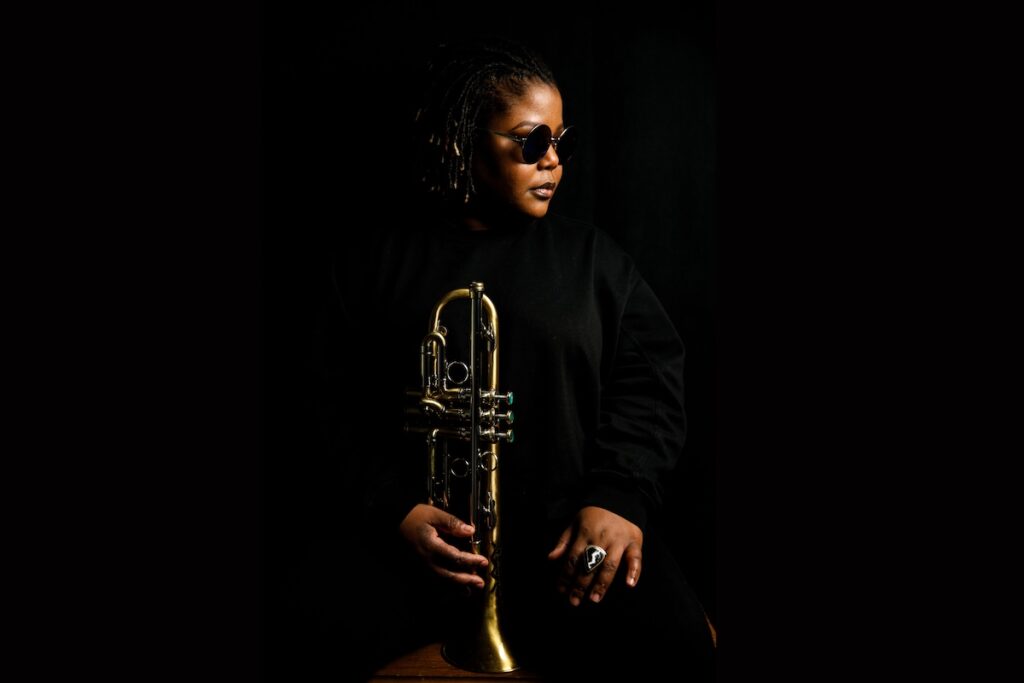
An important component of Mourning [A] BLKstar’s music is its commitment to being genre-nonconforming. Can you talk more about why this is important and the ways it may help or hinder the modern musician?
We create music; music that feels good, tells a story, and carries emotion. We like to call it “heart music”. It’s not about fitting into a genre. In fact, we intentionally avoid labels. Too often, Black artists are boxed into certain categories simply because of their Blackness. We’re not interested in that.
Our creative process is rooted in collaboration. We work together, in the same room, with a focus on connection, intuition, and feel. That sense of togetherness creates a space where we can experiment freely, without boundaries or expectations. It allows us to explore different sounds, voices, and expressions.
For us, that freedom is everything. And as artists, it’s in that freedom where true growth begins.
Creating community is an important throughline in your career. In your experience, what is a detail that often gets overlooked that community builders should consider?
Community work requires patience. Organizing efforts and collaborative projects take time, care, and consistency. True community building doesn’t happen overnight, it’s a process that needs intention and trust.
Equally important is the foundation on which that work is built. Before any organization can uplift a community, it must first turn inward. How can we support others if we haven’t taken the time to check in with ourselves? Self-evaluation and internal alignment are essential. Only from a place of clarity and integrity can meaningful, sustainable change take root.
Our current political climate has brought about an attack on Black art and innovation. What advice do you have for young artists who may be afraid to create?
Now’s the time! We are living in difficult times and artists are actively and intentionally being silenced. More often than not, this happens when they are speaking truth or sharing something of deep importance. Funding is being stripped from arts organizations, and truths are increasingly framed as threats. It can be frightening to keep creating in this kind of climate. But my advice is this: seek out community among those who are still making art. Stay hopeful. And most importantly, keep going.
Create while afraid. Create while angry. Create while anxious. Create while hopeless. Create.
We need your art now more than ever.
I CARE IF YOU LISTEN is an editorially-independent program of the American Composers Forum, and is made possible thanks to generous donor and institutional support. Opinions expressed are solely those of the author and may not represent the views of ICIYL or ACF.
You can support the work of ICIYL with a tax-deductible gift to ACF. For more on ACF, visit composersforum.org.
